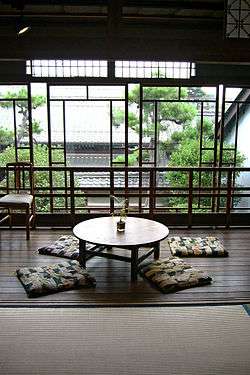Coffee table

A coffee table is a style of long, low table which is designed to be placed in front of (or next to) a sofa or upholstered chairs to support beverages (hence the name), magazines, books (especially large, illustrated coffee table books), decorative objects, and other small items to be used while sitting, such as beverage coasters.[1][2][3] In some situations, such as during a party, plates of food may be placed on the table.
Coffee tables are usually found in the living room or sitting room. They are available in many different variations and prices vary from style to style. Coffee tables may also incorporate cabinets or drawers for storage. The most common construction of coffee tables is out of wood, but metal coffee tables are also popular. Typically, stainless steel or aluminum are used for metal coffee tables. The idiom "Gather round the coffee table" is derived from the furniture piece and its proclivity for encouraging conviviality and light conversation. Coffee tables were thought to initially be constructed in Renaissance England.
Origins

In Europe, the first tables specifically designed as and called coffee tables, appear to have been made in Britain during the late Victorian era.
According to the listing in Victorian Furniture by R. W. Symonds & B. B. Whineray and also in The Country Life Book of English Furniture by Edward T. Joy, a table designed by E. W. Godwin in 1868 and made in large numbers by William Watt, and Collinson and Lock, is a coffee table. If this is correct it may be one of the earliest made in Europe. Other sources, however, list it only as "table" so this can be stated categorically. Far from being a low table, this table was about twenty-seven inches high.
Later coffee tables were designed as low tables and this idea may have come from the Ottoman Empire, based on the tables in use in tea gardens. However, as the Anglo-Japanese style was popular in Britain throughout the 1870s and 1880s and low tables were common in Japan, this seems to be an equally likely source for the concept of a long low table.
From the late 19th century onwards, many coffee tables were subsequently made in earlier styles due to the popularity of revivalism, so it is quite possible to find Louis XVI style coffee tables or Georgian style coffee tables, but there seems to be no evidence of a table actually made as a coffee table before this time. Joseph Aronson writing in 1938 defines a coffee table as a, "Low wide table now used before a sofa or couch. There is no historical precedent...," suggesting that coffee tables were a late development in the history of furniture. With the increasing availability of television sets from the 1950s onwards coffee tables really came into their own since they are low enough, even with cups and glasses on them, not to obstruct the view of the TV.
Also, the use of similar tables has been recorded in the ancient Greek era, following the Roman conquest of North-East Africa.
There is a theory by Koa Stephens, furniture maker and theorist, that the current standard shape and dimensions are in direct relation to Bedouin and Moroccan brass tables. Noting that, "It may be no coincidence that it is called a coffee table since these were the guys that brought coffee to the western world." The theory calls to its support the rise in popularity the oriental rug which is from the same region during the same era as the introduction of the coffee table.